Want to find Neptune the easy way? Just point your binoculars or telescope at Mars the next few nights, when the two planets will be in close conjunction.
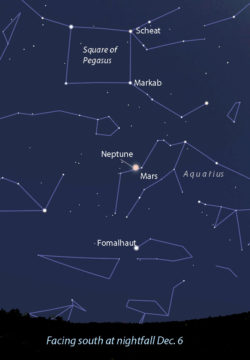
Stellarium
The other night I looked up, saw Mars and realized it wasn't alone. Out of naked-eye range, a much colder, more distant planet was in its sights — Neptune. Mars is headed there in a hurry! Not physically of course. The Red Planet is 8.7 light-minutes from Earth compared to more than 4 light-hours for Neptune, but the line of sight between the two will narrow to mere minutes of arc the next two nights as Mars speeds along its orbit.
Mars and Neptune were in close conjunction two years ago on New Year's Eve. This event will be similar. Depending on your location, from a 1/4° to as little as two arcminutes will separate the odd couple Thursday night (December 6th) and Friday (the 7th).
If you're like me and enjoy seeing multiple planets snugged together in the same telescopic field of view, you won't want to miss this week's opportunity: simply point binoculars or telescope at Mars and see Neptune right next door. Without bright Mars nearby, you'd otherwise have to track down the planet by hopping faint stars in Aquarius.
Neptune shines at magnitude 7.9 in early December and will be visible in 8×40 and 10×50 binoculars from suburban and rural skies parked to the upper left (northeast) of Mars tonight, December 6th, and to its lower right (southwest) on December 7th.
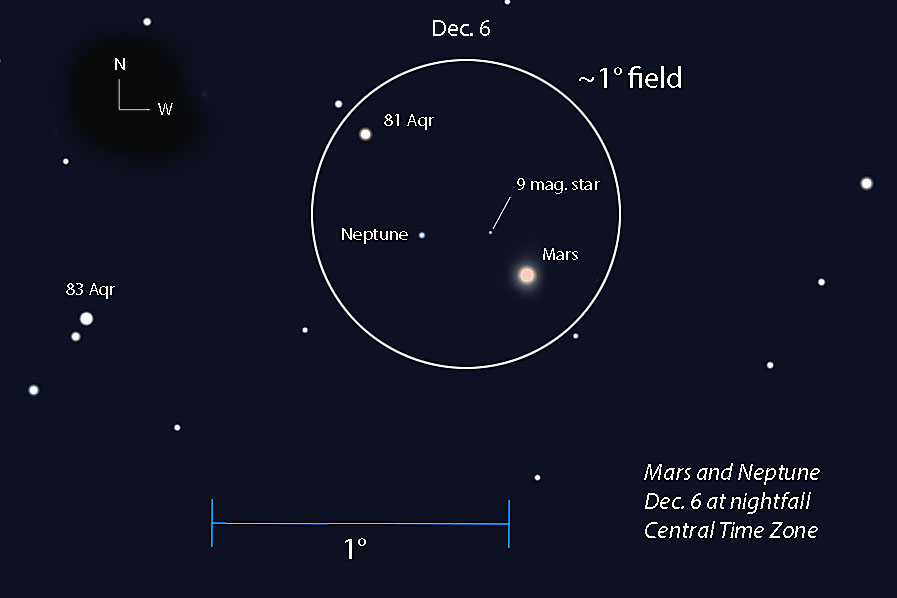
Stellarium with additions by the author
Telescopes of 3-inches and larger will show Neptune with ease. The larger the telescope, the more obvious the color contrast will be between the two planets. Neptune looks blue to me, similar to its appearance in photos and caused by the presence of methane in its atmosphere. Mars's red color comes from iron oxide, better known as rust.
For the central U.S., Mars and Neptune will be 22.5′ apart tonight and 16′ apart on Friday. Western European observers will see them separated by about half-a-degree. tonight and just 7.5′ Friday at nightfall. Closest approach occurs on December 7th about 14h UT when Mars squeaks by the slower planet, missing it by only 1′ 57″. Skywatchers in Asia, India, and parts of Australia will witness this exceptional pass.
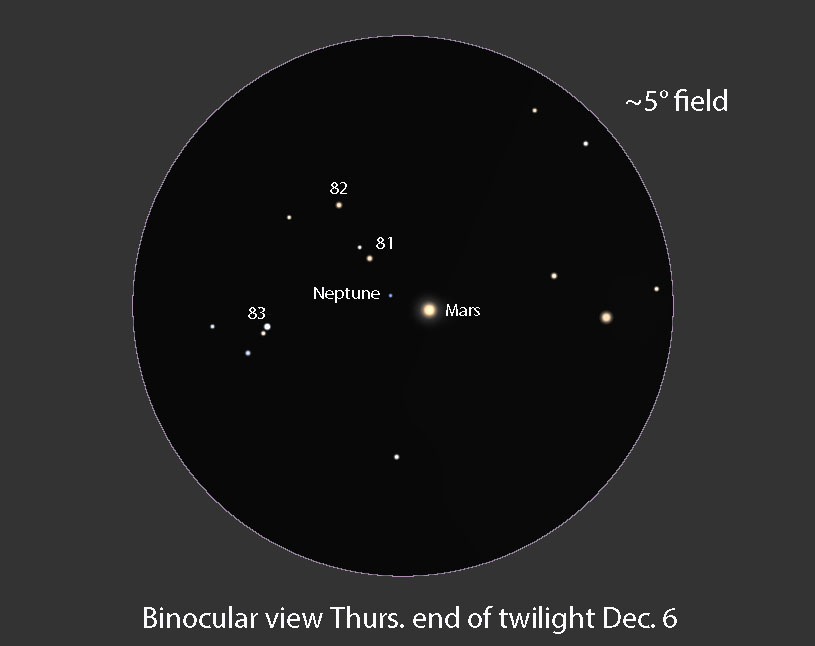
Stellarium
Mars has been shrinking since its summertime opposition and now measures just 8.9″ across. While small, that's still four times Neptune's 2.2″ apparent diameter. For maximum enjoyment in the telescope, cross your fingers for steady skies, so you can increase the magnification to clearly distinguish the disk of each planet. I'd recommend 150×–250×.
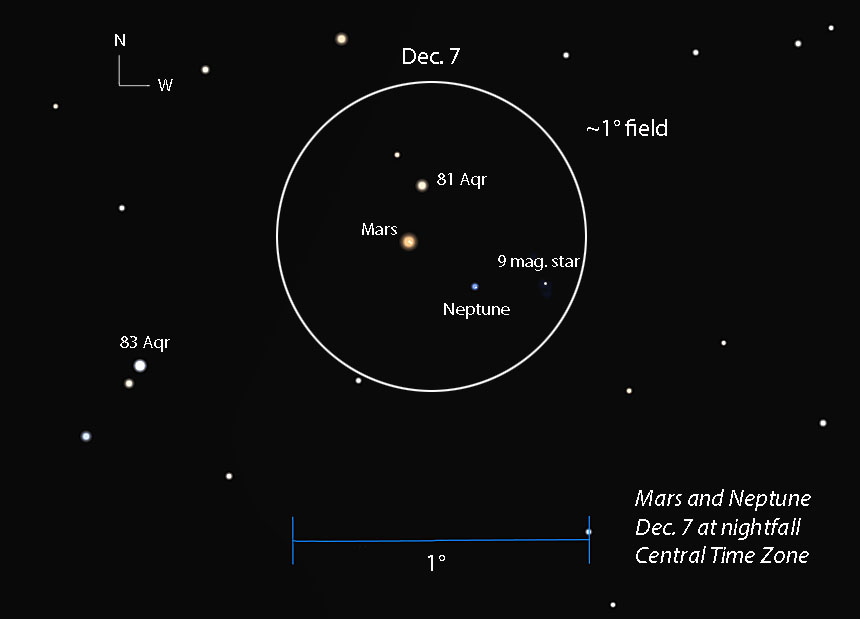
Stellarium
One of the Red Planet's most prominent features, the ancient shield volcano Syrtis Major, will be located on or near the central meridian (squarely in view) for observers in much of the continental U.S. this week. Given the planet's small diameter that may be all you see besides Mars's gibbous phase. Use Sky & Telescope's Mars Profiler for a quick look at what Martian features face your way any time you plan to observe.
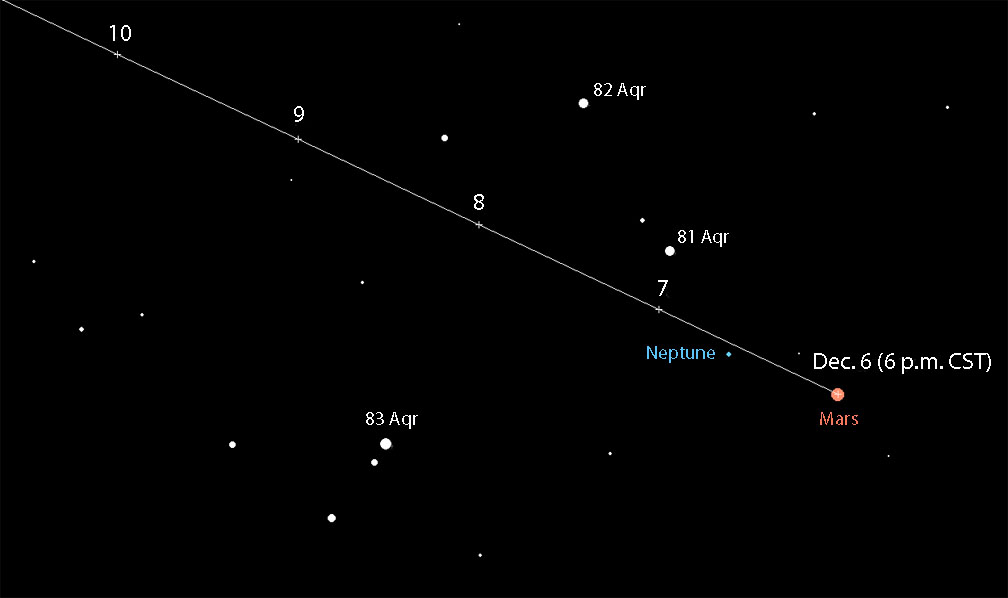
Chris Marriott's SkyMap
Although Neptune appears bland through most amateur telescopes, its brightest moon, Triton, is relatively easy to see at 200× and up. Lucky for us, Triton will be near southern elongation tonight and Friday around 0h UT. To know exactly where to look for it, hop over to the Triton Tracker.
I'm looking forward to this Neptune-Mars encounter as a warm-up for viewing Comet 46P/Wirtanen, which has been steadily brightening a couple constellations to the east in Eridanus. For a cold month, December's been running hot with astronomical fare.
 22
22
Comments
Robert-Casey
December 6, 2018 at 9:59 am
Used a low grade 60mm refractor last night, think I saw Neptune, though it was hard to tell apart from other stars. And my location is nearby New York City, so light pollution is pretty bad. If I did see it, then I have seen all the Sun's planets (if you consider Pluto as a "dwarf planet").
You must be logged in to post a comment.
Bob KingPost Author
December 6, 2018 at 10:22 am
Hi Robert,
Just in case you didn't, it will even easier to identify tonight. You can use the maps in the article to double-check. Good luck in your solar system quest!
You must be logged in to post a comment.
Robert-Casey
December 6, 2018 at 8:19 pm
cloudy tonight. 🙁
You must be logged in to post a comment.
Robert-Casey
December 7, 2018 at 6:07 pm
Using the chart for Dec 7th, I think I can say for sure that I saw Neptune and say "that's it" as I was looking at it!. 🙂
You must be logged in to post a comment.
Bob KingPost Author
December 8, 2018 at 2:17 am
Robert,
Time for a fist pump 🙂
You must be logged in to post a comment.
Robert-Casey
December 8, 2018 at 3:03 pm
Yes. 🙂
You must be logged in to post a comment.
Robert-Casey
December 9, 2018 at 10:00 pm
http://www.wa2ise.com/space/ss.jpg I made myself an award plaque. Includes Earth. Well, I pointed the scope at the ground. 🙂
You must be logged in to post a comment.
john-tudek
December 6, 2018 at 1:45 pm
Congratulations! I think Mercury was my last planet, only because weather never properly cooperated with my schedule. Getting all 8 is something to hang your hat on 🙂
You must be logged in to post a comment.
Rod
December 6, 2018 at 10:42 am
Bob, very good charts here. Last night near 1800 EST, I did see Mars and Neptune using my 90-mm refractor. "Neptune observed tonight with Mars in same FoV at 31x and 96 arcminute true FoV (1.6 degrees). Easy identification because of 81 Aquarii, HIP113709, and 82 Aquarii stars near Neptune tonight. Mars and Neptune closing to 0.3 degree apart 07-Dec-18." Today we have mixed clouds and likely some tonight where I am at but Friday night forecast is mostly clear skies and cold temps mid-20s or colder. I hope to view Mars and Neptune together in same FoV at 140x to 200x views.
You must be logged in to post a comment.
Bob KingPost Author
December 6, 2018 at 2:39 pm
Rod,
Yes, this is one of those times you can use high power to see shapes while still keeping both in the same field. Wishing you clear skies.
You must be logged in to post a comment.
Joe Stieber
December 6, 2018 at 12:29 pm
I’ve been following Neptune with my 15x56 binoculars for many months now, so I haven’t needed a finder chart in a while. My most recent sighting was this past Tuesday (December 4) when I was out to the New Jersey PInes for a look at 46P/Wirtanen and an attempt to see SN 2018ivc with my 12.5-inch scope (the SN was not seen). Mars was closing in on Neptune on Tuesday, and I was wondering if Martian glare would be a problem for the binoculars at their closest approach. Tonight’s (Dec 6) weather forecast isn’t good, but it looks good for Friday, Dec 7, so I’ll find out about the binocular view. I’ll get the 85 mm spotting scope out if necessary.
You must be logged in to post a comment.
Bob KingPost Author
December 6, 2018 at 2:38 pm
Joe,
I'm also curious to see if the Mars glare will make it challenging for some. Certainly for those folks in Europe and Asia on Friday night. I'm betting U.S. observers will see it throughout. I've got clear skies forecast, so I'll be checking here from home.
You must be logged in to post a comment.
Robert-Casey
December 8, 2018 at 3:24 pm
It did help to put Mars just outside the field of view.
You must be logged in to post a comment.
Joe Stieber
December 9, 2018 at 6:56 pm
As it turns out, on Friday evening, 07-Dec-2018, I took a look with my 15x56 binoculars around 7:30 pm EST from my suburban (light polluted) front yard. Neptune was a bit dim, but I really had no trouble seeing it and glare from Mars wasn’t a problem.
You must be logged in to post a comment.
Rod
December 7, 2018 at 6:25 pm
Bob King et al - way cool tonight folks and very good charts! I was out with clear skies and cold temps from 1715-1800 EST near Mars transit time. I used my 90-mm refractor and ran the power to 200x. Neptune bluish disk resolved and Mars distinct yellow-orange gibbous shape obvious. I could just get the two in same FoV. At 72x I was able to enjoy Mars gibbous shape, Neptune blue dot near 8:00 position and 81 Aquarii star and some others in the same FoV, mirror reverse view. Neptune blue dot and Mars color very cool. This would make a good astrophoto 🙂 Understanding the distance to Mars, Neptune and 81 Aquarii star is fun to know when viewing.
You must be logged in to post a comment.
Bob KingPost Author
December 7, 2018 at 7:58 pm
Rod,
Great observation — thanks for sharing it so quickly with readers! I'm headed out for a look presently 🙂
You must be logged in to post a comment.
charles-fannin
December 7, 2018 at 7:47 pm
hey bob , thanks for the tips and charts . i live in the middle of a city but got neptune tonight . i have been enjoying the orange glare of mars for months . neptune is harder but your chart made it easy . c.f.
You must be logged in to post a comment.
Bob KingPost Author
December 8, 2018 at 2:17 am
Thanks, Charles. You're welcome! And you found it from the city no less.
You must be logged in to post a comment.
Rod
December 8, 2018 at 9:11 am
FYI. The 07-Dec-18 telescope views of Mars, Neptune, and 81 Aquarii star in the same field of view is a good opportunity that teaches the accuracy of the heliocentric solar system vs. YouTube videos (I received some more today) that promote a different astronomy concept. The close alignment and predictions were accurate and viewable by amateur astronomers using modest telescopes. 81 Aquarii has published stellar parallax as well as absolute and apparent magnitudes. The inverse square law of light can be used to check the distance to the star as well as the stellar parallax measurement. I enjoy using the Planetary Almanac of Sky & Telescope each month along with other astronomical software I use for observing. The solar system is well defined today in math, distances, elliptical motion, etc. When some folks I know send me alternate universe YouTube videos - I remind them of my notes and observational tests 🙂
You must be logged in to post a comment.
Anthony Barreiro
December 10, 2018 at 6:16 pm
Thursday December 6 was beautifully clear here in San Francisco. I saw Mars and Neptune through 10x42 image-stabilized binoculars. At first I couldn't recognize Neptune in Mars' glare, but after a few moments, once I had calibrated my expectations to the extreme difference in brightnesses, it was easy to see them both simultaneously.
The following evening was still mostly clear. I set up my little refractor on the sidewalk in front of my home during twilight and offered passersby views of Mars and Neptune at 33x magnification, which put both planets and 81 Aqr neatly in the field of view. Those who seemed receptive to further information got a brief description of the sizes, distances from the Sun, and orbital periods of Earth, Mars, and Neptune. It was fun.
You must be logged in to post a comment.
Rod
December 11, 2018 at 7:16 am
Anthony, that is excellent on your report and outreach to others on this astronomical event and helping some to understand the solar system a bit more. Enjoy your stargazing.
You must be logged in to post a comment.
Anthony Barreiro
December 11, 2018 at 6:16 pm
Thanks Rod!
You must be logged in to post a comment.
You must be logged in to post a comment.